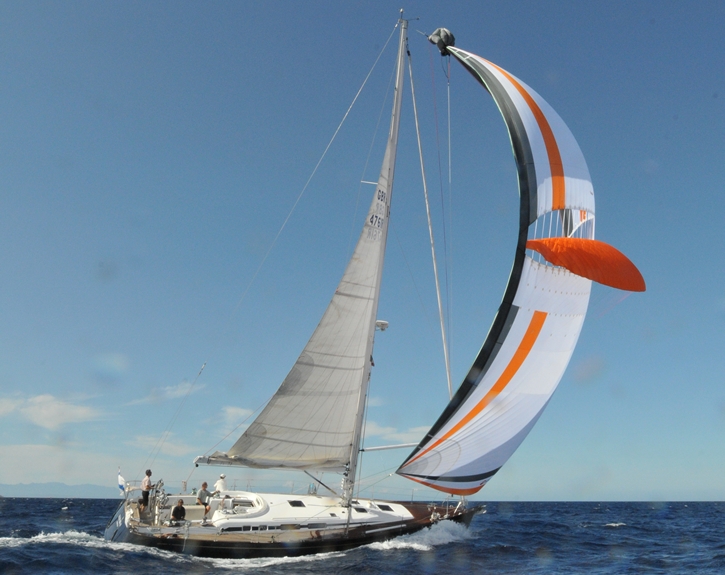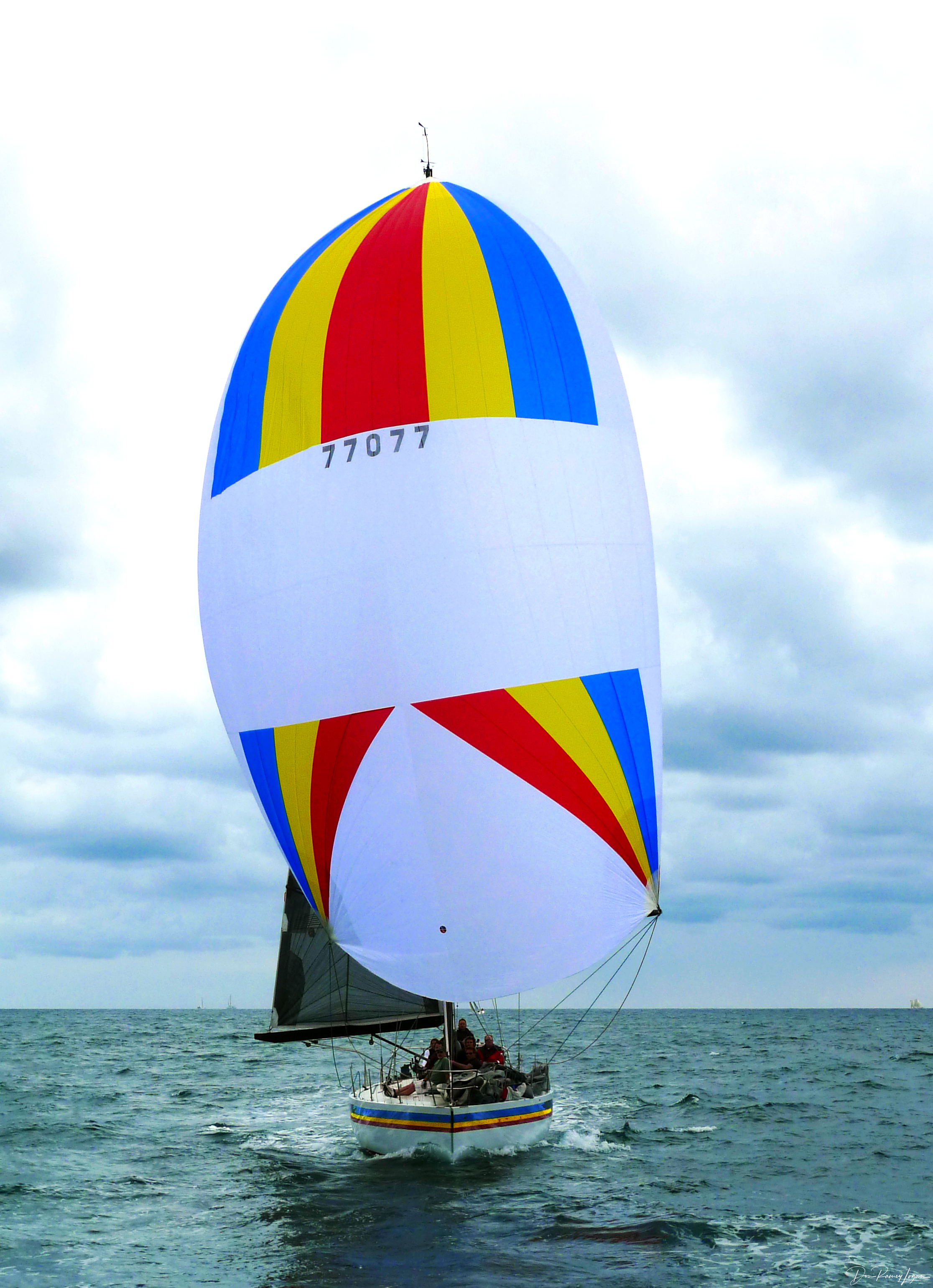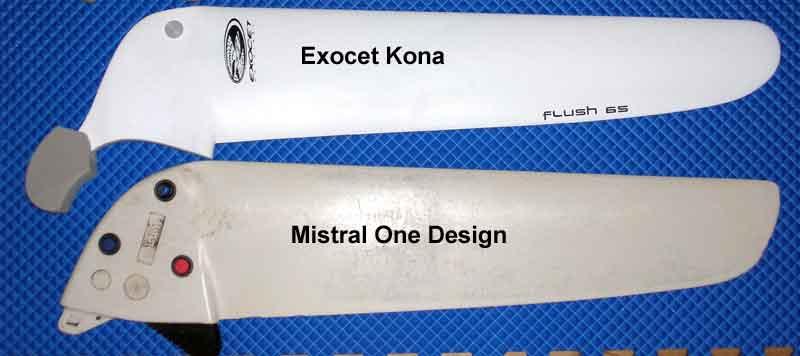|
Swan 53 Mk II
The Swan 53-2, also called the Swan 53 Mk II, is a Finnish sailboat that was designed by Germán Frers as a blue water cruiser and first built in 2005. The design was originally marketed by the manufacturer as the Swan 53, but is now usually referred to as the Swan 53-2 or Mk II, to differentiate it from Frers' unrelated 1987 Swan 53 Mk I design. The boat is a developed into the Swan 54, using the same hull design. Production The design was built by Oy Nautor AB in Finland, from 2005 to 2009 with 20 boats completed, but it is now out of production. Design The Swan 53-2 is a recreational keelboat, built predominantly of glassfibre, with wood trim. It has a masthead sloop rig, with two sets of swept spreaders. The hull has a raked stem plumb stem, a reverse transom, an internally mounted spade-type rudder controlled by dual wheels and a fixed fin keel or optional stub keel and daggerboard. It displaces and carries of lead ballast in the fin keel version and of ballast in ... [...More Info...] [...Related Items...] OR: [Wikipedia] [Google] [Baidu] |
Germán Frers
Germán Frers Sr. (born July 4, 1941) is an Argentinian naval architect known for designing racing yachts. He designed his first yacht in 1958 and has been involved in the design of more than 1000 yachts, including '' Kialoa V'' and '' Hyperion'', which, when launched in 1997 was the largest sloop ever made. Yachts designed by the Frers team have won many different yachting events around the world including: the Admiral's Cup, Onion Patch, Bermuda Race, Transpacific, Whitbread Round the World Race, Sardinia Cup, Buenos Aires-Rio Race, S.O.R.C. (Southern Ocean Racing Circuit), Kenwood Cup, Copa del Rey, San Francisco Big Boat Series, Giraglia Race, Settimana delle Bocche, Two Ton Cup World Championship, Martini Middle Sea Race and the Maxi World Championship. Frers is married to Delfina Serralunga Pes. Their son, Germán Frers Jr., also became a yacht designer, and their daughter, Delfina Frers, is a racing driver. Boat designs * ARA Fortuna III * Beneteau *Cirrus 3/4 (IOR 3 ... [...More Info...] [...Related Items...] OR: [Wikipedia] [Google] [Baidu] |
Masthead Sloop
A masthead rig on a sailing vessel consists of a forestay and backstay both attached at the top of the mast. The Bermuda rig can be split into two groups: the masthead rig and the fractional rig. The masthead rig has larger and more headsails, and a smaller mainsail, compared to the fractional rig. The major advantage a masthead sloop has over a fractional one, is that the jib is larger. Since the jib has no mast in front of it to cause turbulent airflow over it, it is considered much more efficient than the main, especially for sailing up wind. Also, since the fore stay is attached to the top of the mast, it pulls directly against the back stay. Tightening the back stay, then, increases the tension on the fore stay. This is useful because the jib needs considerable fore stay tension to set well. This need increases in direct proportion to the wind speed and jib size. Increasing the tension on the back stay does not tend to bend the mast, as it would on a fractional sloop. It pu ... [...More Info...] [...Related Items...] OR: [Wikipedia] [Google] [Baidu] |
Spinnaker
A spinnaker is a sail designed specifically for sailing off the wind on courses between a Point of sail#Reaching, reach (wind at 90° to the course) to Point of sail#Running downwind, downwind (course in the same direction as the wind). Spinnakers are constructed of lightweight fabric, usually nylon, and are often brightly colored. They may be designed to perform best as either a reaching or a running spinnaker, by the shaping of the panels and seams. They are attached at only three points and said to be ''flown''. Etymology Some dictionaries suggest that the origin of the word could be traced to the first boat to commonly fly a spinnaker, a yacht called ''Sphinx'', mispronounced as ''Spinx''. ''Spinnaker'' entry in The Concise Oxford Dictionary of English Etymology (1996). Oxford University PressAccording to encyclopedia.com Both retrieved on 20 July 2008. ''Sphinx'' first set her spinnaker in the Solent in 1865, and the first recorded use of the word was in 1866 in the Augu ... [...More Info...] [...Related Items...] OR: [Wikipedia] [Google] [Baidu] |
Head (watercraft)
In sailing vessels, the head is the ship's toilet. The name derives from sailing ships in which the toilet area for the regular sailors was placed at the head or bow of the vessel. Design In sailing ships, the toilet was placed in the bow somewhat above the water line with vents or slots cut near the floor level allowing normal wave action to wash out the facility. Only the captain had a private toilet near his quarters, at the stern of the ship in the quarter gallery. The plans of 18th-century naval ships do not reveal the construction of toilet facilities when the ships were first built. The Journal of Aaron Thomas aboard HMS ''Lapwing'' in the Caribbean Sea in the 1790s records that a canvas tube was attached, presumably by the ship's sailmaker, to a superstructure beside the bowsprit near the figurehead, ending just above the normal waterline. In many modern boats, the heads look similar to seated flush toilets but use a system of valves and pumps that brings sea water ... [...More Info...] [...Related Items...] OR: [Wikipedia] [Google] [Baidu] |
Ice Box
An icebox (also called a cold closet) is a compact non-mechanical refrigerator which was a common early-twentieth-century kitchen appliance before the development of safely powered refrigeration devices. Before the development of electric refrigerators, iceboxes were referred to by the public as "refrigerators". Only after the invention of the modern electric refrigerator did early non-electric refrigerators become known as iceboxes. The terms ''ice box'' and ''refrigerator'' were used interchangeably in advertising as long ago as 1848. Origin The first recorded use of refrigeration technology dates back to 1775 BC in the Sumerian city of Terqa. It was there that the region's King, Zimri-lim, began the construction of an elaborate ice house fitted with a sophisticated drainage system and shallow pools to freeze water in the night. Using ice for cooling and preservation was not new at that time; the ice house was an introductory model for the modern icebox. The traditional kit ... [...More Info...] [...Related Items...] OR: [Wikipedia] [Google] [Baidu] |
Companionway
In the architecture of a ship, a companion or companionway is a raised and windowed hatchway in the ship's deck, with a ladder leading below and the hooded entrance-hatch to the main cabins. A companionway may be secured by doors or, commonly in sailboats, ''hatch boards'' which fit in grooves in the companionway frame. This allows the lowest board to be left in place during inclement weather to minimize water infiltration. The term may be more broadly used to describe any ladder between decks. File:Hatchboards.JPG, Set of hatch boards in companionway hatch. File:Hatchboards2.JPG, Set of hatch boards with top board removed. See also * Glossary of nautical terms (other) Glossary of nautical terms may refer to: * Glossary of nautical terms (A–L) This glossary of nautical terms is an alphabetical listing of terms and expressions connected with ships, shipping, seamanship and navigation on water (mostly though n ... References {{sailing ship elements Rooms Wa ... [...More Info...] [...Related Items...] OR: [Wikipedia] [Google] [Baidu] |
Galley (kitchen)
The galley is the compartment of a ship, train, or aircraft where food is cooked and prepared. It can also refer to a land-based kitchen on a naval base, or, from a kitchen design point of view, to a straight design of the kitchen layout. Ship's cooking area A fork galley is the cooking area aboard a vessel, usually laid out in an efficient typical style with longitudinal units and overhead cabinets. This makes the best use of the usually limited space aboard ships. It also caters for the rolling and heaving nature of ships, making them more resistant to the effects of the movement of the ship. For this reason galley stoves are often gimballed, so that the liquid in pans does not spill out. They are also commonly equipped with bars, preventing the cook from falling against the hot stove. A small cooking area on deck is called a caboose or ''camboose'', originating from the , which is still in use today. In English it is a term used only for a cooking area that is abovedecks. A ... [...More Info...] [...Related Items...] OR: [Wikipedia] [Google] [Baidu] |
Fresh Water
Fresh water or freshwater is any naturally occurring liquid or frozen water containing low concentrations of dissolved salt (chemistry), salts and other total dissolved solids. The term excludes seawater and brackish water, but it does include non-salty mineral water, mineral-rich waters, such as chalybeate springs. Fresh water may encompass frozen water, frozen and meltwater in ice sheets, ice caps, glaciers, snowfields and icebergs, natural precipitations such as rainfall, snowfall, hail/ice pellets, sleet and graupel, and surface runoffs that form inland bodies of water such as wetlands, ponds, lakes, rivers, streams, as well as groundwater contained in aquifers, subterranea (geography), subterranean subterranean river, rivers and underground lake, lakes. Water is critical to the survival of all living organisms. Many organisms can thrive on salt water, but the great majority of vascular plants and most insects, amphibians, reptiles, mammals and birds need fresh water to sur ... [...More Info...] [...Related Items...] OR: [Wikipedia] [Google] [Baidu] |
Daggerboard
A daggerboard is a retractable centreboard used by various sailing craft. While other types of centreboard may pivot to retract, a daggerboard slides in a casing. The shape of the daggerboard converts the forward motion into a windward lift, countering the leeward push of the sail. The theoretical centre of lateral resistance is on the trailing edge of the daggerboard. General A daggerboard is a removable vertical keel that is inserted through a "trunk" in the center of a vessel's hull, usually amidships. Daggerboards are usually found in small sailing craft such as day sailers, which are easily handled by a single person. Daggerboards are not usually ballasted but are locked in place by a clip or pin. Unlike a centreboard, which can be set at different angles to the hull of the boat, daggerboards are generally limited to a single perpendicular position relative to the hull. If a daggerboard is located off center, it is called a leeboard or a bilgeboard. The characteristic whi ... [...More Info...] [...Related Items...] OR: [Wikipedia] [Google] [Baidu] |
Keel
The keel is the bottom-most longitudinal structural element of a watercraft, important for stability. On some sailboats, it may have a fluid dynamics, hydrodynamic and counterbalancing purpose as well. The keel laying, laying of the keel is often the initial step in constructing a ship. In the British and American shipbuilding traditions, this event marks the beginning date of a ship's construction. Etymology The word "keel" comes from Old English language, Old English , Old Norse , = "ship" or "keel". It has the distinction of being regarded by some scholars as the first word in the English language recorded in writing, having been recorded by Gildas in his 6th century Latin work ''De Excidio et Conquestu Britanniae'', under the spelling ''cyulae'' (he was referring to the three ships that the Saxons first arrived in). is the Latin word for "keel" and is the origin of the term careening, careen (to clean a keel and the hull in general, often by rolling the ship on its side). An ... [...More Info...] [...Related Items...] OR: [Wikipedia] [Google] [Baidu] |
Ship's Wheel
A ship's wheel or boat's wheel is a device used aboard a ship, boat, submarine, or airship, with which a helmsman steering, steers the vessel and controls its course (navigation), course. Together with the rest of the steering mechanism, it forms part of the helm (the term ''helm'' can mean the wheel alone, or the entire mechanism by which the rudder is controlled). It is connected to a mechanical, electric Servomechanism, servo, or hydraulics, hydraulic system which alters the horizontal angle of the vessel's rudder relative to its Hull (watercraft), hull. In some modern ships the wheel is replaced with a simple toggle that remotely controls an electro-mechanical or electro-hydraulic drive for the rudder, with a rudder position indicator presenting feedback to the helmsman. History Until the invention of the ship's wheel, the helmsman relied on a tiller—a horizontal bar fitted directly to the top of the rudder post—or a whipstaff—a vertical stick acting on the arm of the sh ... [...More Info...] [...Related Items...] OR: [Wikipedia] [Google] [Baidu] |
Reverse Transom
In some boats and ships, a transom is the aft transverse surface of the hull that forms the stern of a vessel. Historically, they are a development from the canoe stern (or "double-ender") wherein which both bow and stern are pointed. Transoms add both strength and width to the stern. They may be flat or curved and they may be vertical, raked forward (known as retroussé), or raked aft. In small boats and yachts, this flat termination of the stern is typically above the waterline, but large commercial vessels often exhibit vertical transoms that dip slightly beneath the water. On cruising boats, a counter stern may be truncated to form a "truncated counter stern", in which there is a part of the stern that approximates a transom. Although that standard stern transom is typically vertical, they may be raked such that there is an overhang above the water, as at the bow. A reverse transom is angled from the waterline forwards. On smaller boats such as dinghies, transoms may be ... [...More Info...] [...Related Items...] OR: [Wikipedia] [Google] [Baidu] |




